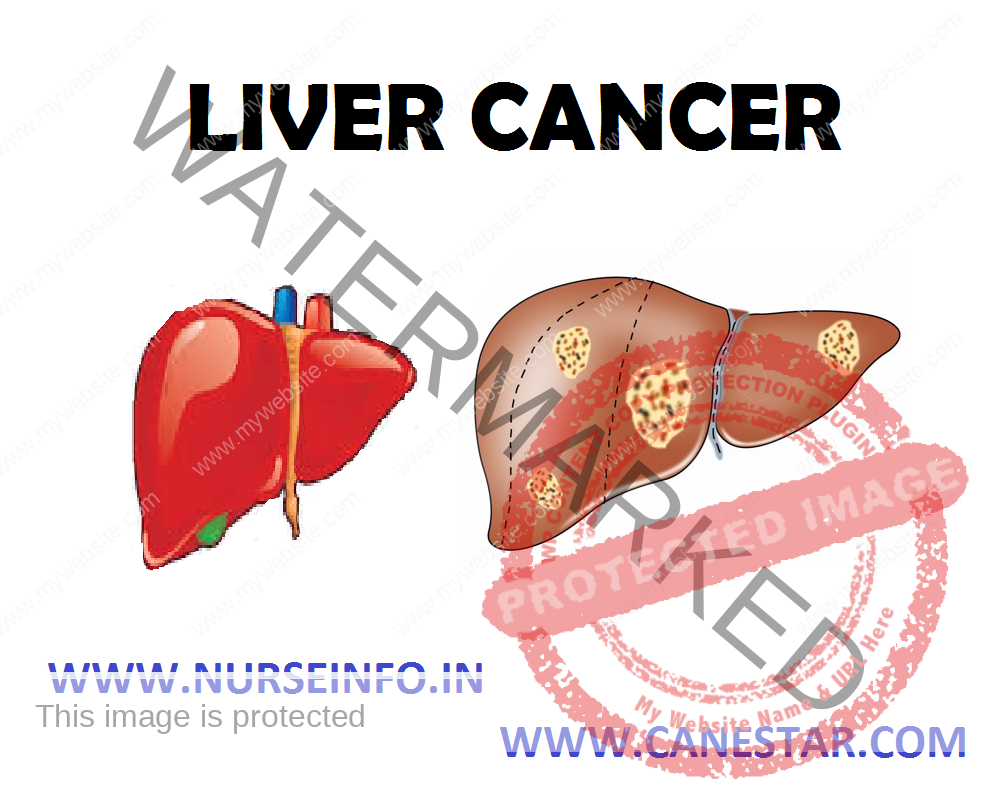LIVER CANCER – Definition, Classification, Etiology and Risk Factors, Signs and Symptoms, Diagnostic Tests and Management
DEFINITION
Liver cancer or hepatic cancer is a cancer that originates in the liver. Liver cancers are malignant tumors that grow on the surface or inside the liver.
CLASSIFICATION
- Primary liver cancer: it can be benign and malignant
Origin Benign Malignant
Hepatocytes – Adenoma Hepatocellular carcinoma
Connective tissue – Fibroma Sarcoma
Blood vessels – Hemangioma hemangioendothelioma
Bile ducts – cholangioma carcinoma
- Secondary (metastatic) liver cancer
Secondary (metastatic) cancer reaches the liver by spreading through the blood system from a primary tumor at a separate site.
- Mixed tumors: rarer forms of liver cancer include:
Mesenchymal tissue
Sarcoma
Hepatoblastoma is a rare malignant tumor, primarily developing in children. Most of these tumors form in the right lobe
Cholangiocarcinoma
Angiosarcoma and hemangiosarcoma
Lymphoma of liver
ETIOLOGY AND RISK FACTORS
- Younger population mainly females
- Chronic liver disease: cirrhosis, HBV and HCV
- Chemical toxins such as vinyl chloride
- Carcinogens in herbal medicines
- Mycotoxins like aflatoxins
- Oral contraceptives
- Metastasis
SIGNS AND SYMPTOMS OF PRIMARY LIVER CANCER
Cholangiocarcinoma
- Sweating
- Jaundice
- Abdominal pain
- Weight loss
- Hepatomegaly
Hepatocellular Carcinoma
- Abdominal mass
- Abdominal pain
- Emesis
- Anemia
- Back pain
- Jaundice
- Itching
- Weigh loss
SIGNS AND SYMPTOMS OF SECONDARY LIVER CANCER
- Tiredness
- Loss of appetite
- Nausea
- A dragging sensation or heaviness felt up under the lower ribs on the right-hand side
- Pain in the upper part of the belly, particularly on bending forwards
DIAGNOSTIC TESTS
- Physical examination and history: the first symptom is usually pain in the right side. Weight loss is common and sometimes patients have episodes of severe pain, fever, and nausea. Rapidly deteriorating health, swelling and jaundice
- Blood tests: most useful in AFP (alpha-fetoprotein). AFP is a protein produced by the liver, and an elevated level can indicate tumor growth, though some patients with liver cancer have normal AFP levels
- CEA (carcinoembryonic antigen) test
- Diagnostic imaging: ultrasound scan, CT and MRI scans are required liver imaging may include a four-phase computed tomography (CT), including spiral CT scans obtained during hepatic arterial and portal venous phases following intravenous contrast administration, or magnetic resonance imaging (MRI). These techniques can accurately demonstrate the number of primary tumors within the liver and their relationship to vascular structures.
- Image-guided biopsy
MANAGEMENT
The correct treatment of liver cancer can mean the difference between life and death. Not all patients with cancers in the liver are potentially curable. These are some of the treatments available: surgery, chemotherapy, immunotherapy, photodynamic therapy, hyperthermia, radiation therapy and radiosurgery.
Hepatocellular Carcinoma
- Partial hepatectomy to resect the entire tumor
- Liver transplantation
- Cryoablation
- Chemoembolization
- Radiotherapy
- Sorafenib
- Radiofrequency ablation
Cholangiocarcinoma
- Photodynamic therapy
- Brachytherapy
- Radiotherapy
- Liver transplantation
Hepatoblastoma
- Chemotherapy, including vincristine, cyclophosphamide and doxorubicin
- Radiotherapy
- Liver transplantation
- Surgical resection

LIVER CANCER – Definition, Classification, Etiology and Risk Factors, Signs and Symptoms, Diagnostic Tests and Management

